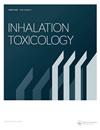一种基于过滤器的系统,模拟人类呼吸系统中的颗粒沉积和渗透,用于二手烟的产生和表征
IF 2
4区 医学
Q4 TOXICOLOGY
引用次数: 2
摘要
二手烟既危害环境,也危害非吸烟者的健康。由于人类受试者产生的可重复数据的稀缺性,因此能够产生具有代表性的二手烟的系统对于研究烟雾特性至关重要。这项工作提出了一个基于过滤器的系统的设计和验证,该系统可以模拟人体呼吸系统中二手烟产生和表征的颗粒沉积和渗透。在我们对常见材料的粒径依赖性过滤效率的研究的指导下,我们确定了三种过滤介质,与人体呼吸系统的不同区域相比,在广泛的亚微米尺寸范围内产生相似的颗粒沉积效率。我们在不同的操作条件下演示了所提出的基于滤波器的系统的性能。此外,我们比较了二手烟颗粒和一次烟雾颗粒的特性。结果在30 ~ 500 nm范围内,基于过滤器的气溶胶沉积效率与国际放射防护委员会(ICRP)模型的差异小于10%。在二手烟中检测到高浓度的金属。二手电子烟产生的镍和铬含量至少超过规定日最大摄入量的20倍和5倍。鉴于基于过滤器的系统与ICRP模型在气溶胶呼吸沉积方面的一致性,该系统结构简单,可重复性高,易于控制,且不需要人体受试者,可以促进二手烟的实验室研究。本文章由计算机程序翻译,如有差异,请以英文原文为准。
A filter-based system mimicking the particle deposition and penetration in human respiratory system for secondhand smoke generation and characterization
Abstract Introduction Secondhand smoke endangers both the environment and the health of nonsmokers. Due to the scarcity of repeatable data generated by human subjects, a system capable of generating representative secondhand smoke is essential for studying smoke properties. This work presents the design and validation of a filter-based system that could mimic the particle deposition and penetration in human respiratory system for secondhand smoke generation and characterization. Methods Guided by our study on characterizing size-dependent filtration efficiency of common materials, we identified three filter media that generate similar particle deposition efficiencies compared to different regions of the human respiratory system over a wide submicron size range. We demonstrated the performance of the proposed filter-based system using various operating conditions. Additionally, we compared the properties of secondhand smoke particles to those of primary smoke particles. Results The difference in aerosol deposition efficiencies between the filter-based system and the International Commission on Radiological Protection (ICRP) model was less than 10% in the size range of 30 to 500 nm. High concentrations of metals were detected in the secondhand smoke. The contents of Ni and Cr generated from the secondhand electronic cigarettes are at least 20 and 5 times above the regulated daily maximum intake amount. Conclusion Given the agreement in aerosol respiratory deposition between the filter-based system and the ICRP model, such a system can facilitate laboratory studies of secondhand smoke due to its simple structure, high repeatability, and ease of control while remaining free of human subjects.
求助全文
通过发布文献求助,成功后即可免费获取论文全文。
去求助
来源期刊

Inhalation Toxicology
医学-毒理学
CiteScore
4.10
自引率
4.80%
发文量
38
审稿时长
6-12 weeks
期刊介绍:
Inhalation Toxicology is a peer-reviewed publication providing a key forum for the latest accomplishments and advancements in concepts, approaches, and procedures presently being used to evaluate the health risk associated with airborne chemicals.
The journal publishes original research, reviews, symposia, and workshop topics involving the respiratory system’s functions in health and disease, the pathogenesis and mechanism of injury, the extrapolation of animal data to humans, the effects of inhaled substances on extra-pulmonary systems, as well as reliable and innovative models for predicting human disease.
 求助内容:
求助内容: 应助结果提醒方式:
应助结果提醒方式:


